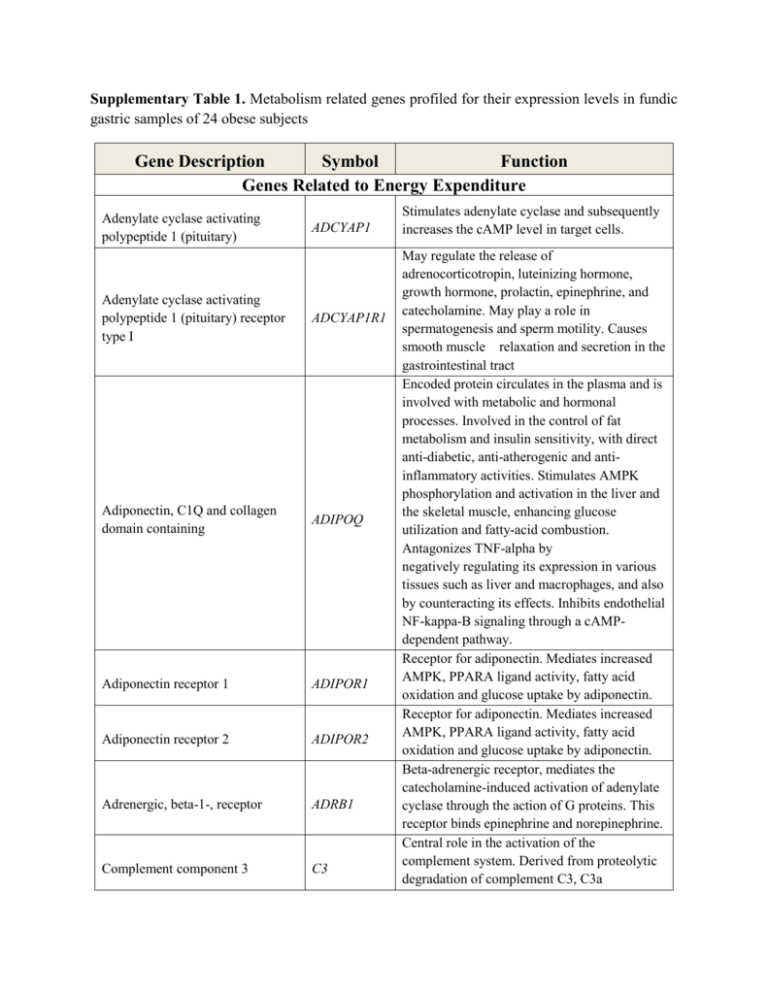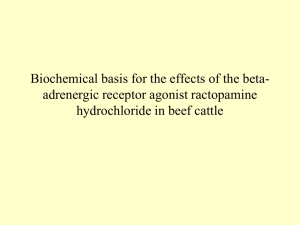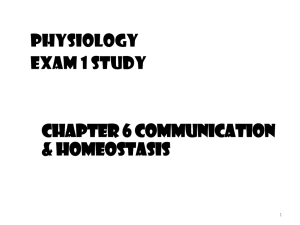file - BioMed Central
advertisement

Supplementary Table 1. Metabolism related genes profiled for their expression levels in fundic gastric samples of 24 obese subjects Gene Description Symbol Function Genes Related to Energy Expenditure Adenylate cyclase activating polypeptide 1 (pituitary) ADCYAP1 Adenylate cyclase activating polypeptide 1 (pituitary) receptor type I ADCYAP1R1 Adiponectin, C1Q and collagen domain containing ADIPOQ Adiponectin receptor 1 ADIPOR1 Adiponectin receptor 2 ADIPOR2 Adrenergic, beta-1-, receptor ADRB1 Complement component 3 C3 Stimulates adenylate cyclase and subsequently increases the cAMP level in target cells. May regulate the release of adrenocorticotropin, luteinizing hormone, growth hormone, prolactin, epinephrine, and catecholamine. May play a role in spermatogenesis and sperm motility. Causes smooth muscle relaxation and secretion in the gastrointestinal tract Encoded protein circulates in the plasma and is involved with metabolic and hormonal processes. Involved in the control of fat metabolism and insulin sensitivity, with direct anti-diabetic, anti-atherogenic and antiinflammatory activities. Stimulates AMPK phosphorylation and activation in the liver and the skeletal muscle, enhancing glucose utilization and fatty-acid combustion. Antagonizes TNF-alpha by negatively regulating its expression in various tissues such as liver and macrophages, and also by counteracting its effects. Inhibits endothelial NF-kappa-B signaling through a cAMPdependent pathway. Receptor for adiponectin. Mediates increased AMPK, PPARA ligand activity, fatty acid oxidation and glucose uptake by adiponectin. Receptor for adiponectin. Mediates increased AMPK, PPARA ligand activity, fatty acid oxidation and glucose uptake by adiponectin. Beta-adrenergic receptor, mediates the catecholamine-induced activation of adenylate cyclase through the action of G proteins. This receptor binds epinephrine and norepinephrine. Central role in the activation of the complement system. Derived from proteolytic degradation of complement C3, C3a Carboxypeptidase D CPD Carboxypeptidase E CPE Peroxisome proliferator-activated receptor alpha PPARA Peroxisome proliferator-activated receptor gamma PPARG Peroxisome proliferator-activated receptor gamma, coactivator 1 alpha PPARGC1A Uncoupling protein 1 (mitochondrial, proton carrier) UCP1 Protein tyrosine phosphatase, nonreceptor type 1 PTPN1 Sigma non-opioid intracellular receptor 1 SIGMAR1 Thyroid hormone receptor, beta (erythroblastic leukemia viral (verb-a) oncogene homolog 2, avian) THRB anaphylatoxin is a mediator of local inflammatory process. Regulatory B-type carboxypeptidase belonging to metallocarboxypeptidase family of enzymes. Involved in the biosynthesis of peptide hormones and neurotransmitters, including insulin. Nuclear transcription factor, key regulator of lipid metabolism. Regulates the peroxisomal beta-oxidation pathway of fatty acids. Nuclear transcription factor. Regulator of adipocyte differentiation and glucose homeostasis. Controls the peroxisomal betaoxidation pathway of fatty acids. Implicated in the pathology of numerous diseases including obesity, diabetes, atherosclerosis and cancer. Interacts with PPARg. Transcriptional coactivator for steroid receptors and nuclear receptors. Regulate the activities of, cAMP response element binding protein (CREB) and nuclear respiratory factors (NRFs). Can regulate key mitochondrial genes that contribute to the program of adaptive thermogenesis. Mitochondrial uncoupling proteins, expressed only in brown adipose tissue, a specialized tissue which functions to produce heat. Negative regulator of insulin signaling by dephosphorylating the phosphotryosine residues of insulin receptor kinase. dephosphorylate epidermal growth factor receptor kinase, as well as JAK2 and TYK2 kinases. Play an important role in the cellular functions of various tissues associated with the endocrine, immune, and nervous systems. Functions in lipid transport from the endoplasmic reticulum. Also regulates ion channels like the potassium channel and could modulate neurotransmitter release Nuclear hormone receptor for triiodothyronine. Orexigenic Genes Adrenergic, alpha-2B-, receptor ADRA2B Agouti related protein homolog (mouse) AGRP Cannabinoid receptor 1 (brain) CNR1 Galanin prepropeptide GAL Galanin receptor 1 GALR1 Ghrelin/obestatin prepropeptide GHRL Growth hormone secretagogue receptor GHSR Melanin-concentrating hormone receptor 1 MCHR1 Hypocretin (orexin) receptor 1 HCRTR1 Neuropeptide Y NPY Neuropeptide Y receptor Y1 NPY1R Nuclear receptor subfamily 3, group C, member 1 (glucocorticoid receptor) NR3C1 Opioid receptor, kappa 1 OPRK1 Mediate the catecholamine-induced inhibition of adenylate cyclase through the action of G proteins. Antagonist of the melanocortin-3 and melanocortin-4 receptor. Plays a role in weight homeostasis. Involved in cannabinoid-induced CNS effects. Acts by inhibiting adenylate cyclase. Contracts smooth muscle of the gastrointestinal and genitourinary tract, regulates growth hormone release, modulates insulin release, and may be involved in the control of adrenal secretion. Receptor for GAL, inhibits adenylyl cyclase via a G protein of the Gi/Go family. Encodes ghrelin-obestatin preproprotein. Ghrelin has an appetite-stimulating effect, induces adiposity and stimulates gastric acid secretion. Obestatin has appetite-reducing effect resulting in decreased food intake. May reduce gastric emptying activity and jejunal motility. Receptor for ghrelin. Stimulates growth hormone secretion. G protein-coupled receptor family 1. Inhibit cAMP accumulation and stimulate intracellular calcium flux. G-protein coupled receptor involved in the regulation of feeding behavior. Implicated in the control of feeding and in secretion of gonadotrophin-release hormone Receptor for neuropeptide Y and peptide YY. Function both as a transcription factor and as a regulator of other transcription factors. It is involved in inflammatory responses, cellular proliferation, and differentiation in target tissues. Inhibits neurotransmitter release by reducing calcium ion currents and increasing potassium ion conductance. Receptor for dynorphins. May play a role in arousal and regulation of Opioid receptor, mu 1 OPRM1 autonomic and neuroendocrine functions. Inhibits neurotransmitter release by reducing calcium ion currents and increasing potassium ion conductance.Receptor for beta-endorphin. Anorectic Genes Apolipoprotein A-IV APOA4 Attractin ATRN Brain-derived neurotrophic factor BDNF Bombesin-like receptor 3 BRS3 Calcitonin-related polypeptide alpha CALCA Calcitonin Receptor CALCR CART prepropeptide CARTPT Cholecystokinin CCK Cholecystokinin A receptor CCKAR Colipase, pancreatic CLPS Ciliary neurotrophic factor receptor CNTFR Corticotropin releasing hormone receptor 1 CRHR1 May have a role in chylomicrons and VLDL secretion and catabolism. Required for efficient activation of lipoprotein lipase. Involved in the initial immune cell clustering during inflammatory response. May regulate chemotactic activity of chemokines. May play a role in melanocortin signaling pathways that regulate energy homeostasis. May play a role in the regulation of stress response and in the biology of mood disorders. Mediates its action by association with G proteins that activate a phosphatidylinositolcalcium second messenger system. Involved in calcium regulation and acts to regulate phosphorus metabolism. Involved in maintaining calcium homeostasis and in regulating osteoclast-mediated bone resorption. Satiety factor inhibits both normal and starvation-induced feeding and completely blocks the feeding response induced by neuropeptide Y and regulated by leptin in the hypothalamus. Induces gall bladder contraction and the release of pancreatic enzymes in the gut. In the central and peripheral nervous system this receptor regulates satiety and the release of beta-endorphin and dopamine. Cofactor of pancreatic lipase and has a biological activity as a satiety signal. Plays a critical role in neuronal cell survival, differentiation and gene expression. Single nucleotide polymorphisms in this gene may be associated early onset of eating disorders. Essential for the activation of signal transduction pathways that regulate diverse physiological processes including stress, Dopamine receptor D1 DRD1 Dopamine receptor D2 DRD2 Glucagon GCG Glucagon receptor GCGR Growth hormone 1 GH1 Growth hormone 2 GH2 Growth hormone receptor GHR Glucagon-like peptide 1 receptor GLP1R Gastrin-releasing peptide GRP Gastrin-releasing peptide receptor GRPR Hypocretin (orexin) neuropeptide precursor HCRT Histamine receptor H1 HRH1 5-hydroxytryptamine (serotonin) HTR2C reproduction, immune response and obesity. Stimulates adenylyl cyclase and activates cyclic AMP-dependent protein kinases. Inhibits adenylyl cyclase activity. Key role in glucose metabolism and homeostasis. Receptor plays a central role in regulating the level of blood glucose by controlling the rate of hepatic glucose production and insulin secretion. Important role in growth control. Stimulate the liver and other tissues to secrete IGF-1. Also stimulates amino acid uptake and protein synthesis. Important role in growth control. Stimulate the liver and other tissues to secrete IGF-1. Also stimulates amino acid uptake and protein synthesis. On ligand binding, couples to the JAK2/STAT5 pathway. Receptor activity mediated by G proteins which activate adenylyl cyclase. Role in delaying gastric emptying and regulating appetite. Regulate release of gastrointestinal hormones smooth muscle cell contraction, and epithelial cell proliferation. Mediates its action by association with G proteins that activate a phosphatidylinositolcalcium second messenger system. Encodes a hypothalamic neuropeptide precursor protein that gives rise to two mature neuropeptides, orexin A and orexin B, by proteolytic processing. Role in feeding behavior, metabolism, and homeostasis In peripheral tissues, the H1 subclass of histamine receptors mediates the contraction of smooth muscles, increase in capillary permeability as well as mediating neurotransmission in the central nervous system. Receptor for serotonin, receptor mediates its action by association with G proteins that receptor 2C Islet amyloid polypeptide IAPP Interleukin 1, alpha IL1A Interleukin 1, beta IL1B Interleukin 1 receptor, type I IL1R1 Interleukin 6 (interferon, beta 2) IL6 Interleukin 6 receptor IL6R Insulin INS Insulin receptor INSR Leptin LEP Leptin receptor LEPR Melanocortin 3 receptor MC3R activate a phosphatidylinositol-calcium second messenger system. Selectively inhibits insulin-stimulated glucose utilization and glycogen deposition in muscle, while not affecting adipocyte glucose metabolism. Produced by activated macrophages, IL-1 stimulates thymocyte proliferation by inducing IL-2 release, B-cell maturation and proliferation, and fibroblast growth factor activity. IL-1 proteins are involved in the inflammatory response. Produced by activated macrophages, IL-1 stimulates thymocyte proliferation by inducing IL-2 release, B-cell maturation and proliferation, and fibroblast growth factor activity. IL-1 proteins are involved in the inflammatory response. Receptor for interleukin-1 alpha (IL-1A), beta (IL-1B), and interleukin-1 receptor antagonist protein (IL-1RA). Binding to the agonist leads to the activation of NF-kappa-B. Primarily produced at sites of acute and chronic inflammation, where it is secreted into the serum and induces a transcriptional inflammatory response through interleukin 6 receptor, alpha. Activation leads to the regulation of the immune response, acute-phase reactions and hematopoiesis. Insulin decreases blood glucose concentration. It increases cell permeability to monosaccharides, amino acids and fatty acids. It accelerates glycolysis, the pentose phosphate cycle, and glycogen synthesis in liver. Binds insulin and has a tyrosine-protein kinase activity. Plays a major role in the regulation of body weight. On ligand binding, mediates signaling through JAK2/STAT3. Involved in the regulation of fat metabolism. A G-protein-coupled receptor for melanocytestimulating hormone and adrenocorticotropic hormone. Activation mediated by G proteins which activate adenylate cyclase. Neuromedin B NMB Stimulates smooth muscle contraction Neuromedin B receptor NMBR Neuromedin U NMU Neuromedin U receptor 1 NMUR1 Neurotrophic tyrosine kinase, receptor, type 2 NTRK2 Neurotensin NTS involved in the regulation of many biological functions including sensory transmission, thermoregulation, feeding, pituitary, gastric and pancreatic secretion. Stimulates muscle contractions of specific regions of the gastrointestinal tract. Mediate diverse biological effects including contraction of the uterus, peripheral vasoconstriction causing hypertension and activation of the HPA axis resulting in decreased food intake via the CRH system. Tyrosine-protein kinase receptor for brainderived neurotrophic factor (BDNF), neurotrophin-3 and neurotrophin-4/5. Role in endocrine or paracrine role in the regulation of fat metabolism. Neurotensin receptor 1 (high affinity) NTSR1 Activates a phosphatidylinositol-calcium second messenger system. Proopiomelanocortin POMC Prolactin releasing hormone receptor PRLHR Peptide YY PYY Receptor (G protein-coupled) activity modifying protein 3 RAMP3 Sortilin 1 SORT1 Somatostatin SST Wide range of physiological functions, including pigmentation, energy homeostasis, inflammation, immunomodulation, steroidogenesis and temperature control. Implicated in lactation, regulation of food intake and pain-signal processing. Gut peptide inhibits exocrine pancreatic secretion, has a vasoconstrictory action and inhibits jejuna and colonic mobility Transports the calcitonin gene-related peptide type 1 receptor (CALCRL) to the plasma membrane. Acts as a receptor for adrenomedullin (AM) together with CALCRL. Sorting receptor in the Golgi compartment and as a clearance receptor on the cell surface. Probably required in adipocytes for the formation of specialized storage vesicles containing the glucose transporter GLUT4. Inhibits the release of somatotropin. Couples to adenylyl cyclase, PLC, K+ channels, Ca2+ Somatostatin receptor 2 SSTR2 Tumor necrosis factor TNF Thyrotropin-releasing hormone TRH Urocortin UCN Zinc finger protein 91 homolog (mouse) ZFP91 channels and others. Coupled to inhibition of adenylyl cyclase. In addition it stimulates phosphotyrosine phosphatase and PLC. Secreted by macrophages. Binds to receptors TNFRSF1A/TNFR1 and TNFRSF1B/TNFBR. Involved in the regulation of wide spectrum of biological processes including cell proliferation, differentiation, apoptosis, lipid metabolism, and coagulation. Responsible for the regulation and release of thyroid-stimulating hormone, as well as prolactin. Stimulates the secretion of adrenocorticotropic hormone (ACTH). Belongs to zinc finger family of proteins, regulator of the non-canonical NF-kappaB pathway in lymphotoxin-beta receptor signaling. May also play an important role in cell proliferation and/or anti-apoptosis. Housekeeping Genes Beta-2-microglobulin B2M Used as normalization control Hypoxanthine phosphoribosyltransferase 1 HPRT1 Used as normalization control Ribosomal protein L13a RPL13A Used as normalization control Glyceraldehyde-3-phosphate dehydrogenase GAPDH Used as normalization control Actin, beta ACTB Used as normalization control


![Shark Electrosense: physiology and circuit model []](http://s2.studylib.net/store/data/005306781_1-34d5e86294a52e9275a69716495e2e51-300x300.png)






